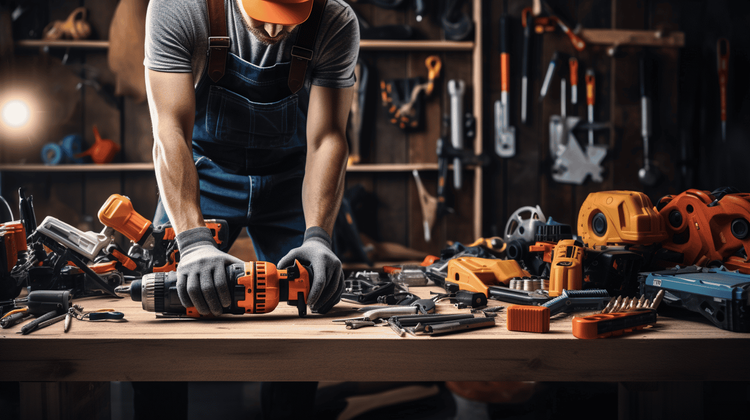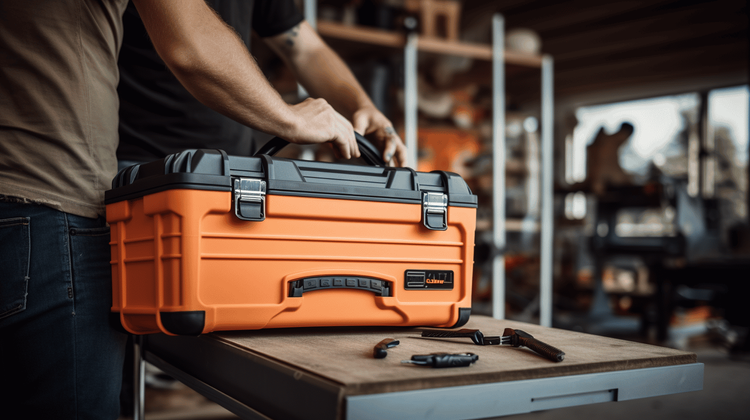Mastering DIY Projects: Top Economical Tools on eCommerce Platforms

Hello, fellow DIY enthusiasts! Have you been contemplating how to commence your journey into the imaginative world of Do-It-Yourself, fondly known as DIY? Or are you an experienced DIY-er, on the hunt for budget-friendly tools to level up your game? This treasure trove of a guide is designed just for you! 🛠️
The surge in DIY-based home improvement projects isn't a new trend. Over the years, the gratification derived from creating something all by yourself has folks not only nurturing their creative instincts but also discovering a novel way to save a few bucks. And in today's digital age, where everything is just a click away, finding affordable yet dependable tools on eCommerce platforms has never been easier.
In this comprehensive guide, we shed light on the fundamental aspects of DIY projects, the tools that never leave a DIY-er's side, and how you can effortlessly navigate eCommerce platforms to find these tools. Armed with these insights, you can preserve your tools' longevity, ensuring that they remain your trusted allies for many projects to come. So, without further ado, let's get the engines revving and drive headfirst into the exhilarating world of DIY projects! 🚀
Feeling bored at home or just itching to unleash your creativity? DIY, or Do-It-Yourself, projects could be exactly what you need. But trust us, it's not just about battling boredom or sparking creativity. The benefits can extend way beyond that!
Why DIY Projects?
Embarking on DIY projects can be an incredibly rewarding experience, transforming ordinary individuals into passionate creators. Here’s why you might want to consider immersing yourself in the world of DIY:
- Unleashing Your Creativity 🎨: Many people have a creative spirit that’s waiting to be set free. DIY projects provide a platform to express that creativity and develop unique, personalized items. Clipboards get replaced with canvases; pencils become paintbrushes.
- Saving Money 💰: Whether you're decorating a room or building a coffee table, doing it yourself can often save you some pretty pennies. All you need to do is figure out the materials you'll need, source them frugally, and get started!
- Therapeutic Benefits 💆: Immersing oneself in DIY projects can help you unwind, decrease stress, and improve your mood—almost like yoga, but with paint and glue guns!
- Environmental Impact ♻: Repurposing or upcycling items not only tackles the challenge of waste but also reduces the need for new products. Thus, DIY projects can contribute to a healthier planet.
Remember, no project is too small or insignificant. Each creation is a manifestation of your ideas, an embodiment of your effort, valuable in its own right.
Common Types of DIY Projects
When it comes to DIY projects, the possibilities are virtually endless. Yet, for those just starting on their DIY journey, here are some typical categories to consider:
- Home Décor: This could range from painting a mural on your wall to crafting handmade candles.
- Furniture: With a little patience and the right tools, you can build your own coffee table or even a bookshelf!
- Fashion and Accessories: This category includes activities like customizing clothes or creating unique jewelry pieces.
- Gardening: From creating a miniature fairy garden in a jar to building raised plant beds – there's a lot to be done here!
Tip: Gear your first DIY project towards something you’re already passionate about, or something you need and know you'd enjoy making.
To begin your DIY journey, remember, you don’t need to be an expert or have all the fanciest tools. Given the abundance of resources available online, a good dose of motivation and a sprinkling of creativity are all you need to get started!
So, what are you waiting for? Embrace the DIY spirit, harness the inner creator within you and let the creating begin!
If you've recently discovered the satisfaction that comes from completing DIY projects at home, welcome to a world brimming with creativity and self-fulfillment. But before you can start crafting magic, you need to equip yourself with the right tools. Now, you might wonder "What are the most economical tools for my DIY projects?" Well, don't worry! This article covers all levels of DIY enthusiasts, from the starry-eyed beginners to the seasoned experts.
Toolkits Essentials for Beginners
When you're just starting with your journey into DIY projects, it's essential to assemble a basic toolkit. To strike a balance between budget and utility, here are some indispensable yet economical tools that every beginner should consider:
- Hammer: An absolute must. For a start, you don't need anything fancy – a simple claw hammer will do the job.
- Screwdrivers: Opt for a variety pack with different head styles and sizes.
- Measuring Tape: Precision is key to a polished DIY project. A good tape measure can ensure you leave nothing to chance.
- Utility Knife: From opening packages to trimming wallpaper, the uses are countless.
- Pliers: Handy for both holding small objects and bending material.
Remember, when it comes to choosing tools, quality trumps quantity. Buying a more resilient tool may be more economical in the long run.
Specialized Tools for Advanced Projects
As you dive deeper into the world of DIY, you may find yourself needing more specialized tools. It's important to invest wisely in these - remember the adage "buy cheap, buy twice." Here are some advanced tools you might consider:
- Power Drill: Nothing screams advanced DIY like a powerful drill. You’ll wonder how you got by without it.
- Electric Sander: This can save you a heap of time and energy compared to manual sanding.
- Table Saw: This is often considered the heart of a woodworking shop.
While these tools may seem pricey, they're critical to tackling advanced projects. Plus, acquiring them over time will lessen the financial impact.
Safety Gear and Its Importance
With the thrill of DIY projects, it’s easy to overlook safety measures. But remember, no project is worth risking your well-being for. A few essential safety items include:
- Safety Glasses: Protect your eyes from flying debris.
- Ear Protection: Power tools can be loud, and consistent noise can harm your hearing.
- Dust Mask: Breathing in dust particles can be harmful over time.
Always 'play it safe'. It's the best strategy for ensuring many more years of creating and enjoying DIY Projects.
DIY is a doorway to self-reliance, creativity, and economic living. With the right tools under your belt, there’s no limit to what you can create in your personal workshop. Here's to bringing your dream projects to life!
In the vast ocean of eCommerce platforms, picking the right tool for your business can be as exciting as it is daunting. With a plethora of options available, the challenge lies not in the lack of choices but in making the perfect choice. So, how do we navigate through this realm of endless possibilities? The answer is simple: by focusing not on every shiny tool that surfaces but on the ones best suited to our needs. Now, let's dive in and decipher three practical steps dedicated to this endeavor: Browsing tools based on projects, Checking tool specifications, and Reading user ratings and comments. 😊
Browsing Tools Based on Projects
Every project has its unique requirements. Because of this, different operations mandate different tools. Hence, the first step should be to narrow down tools based on specific project needs.🧐
Here's what to keep in mind:
- Type of Project: Whether it's an eCommerce website, an online art gallery, a booking platform, or a blog...the nature of your project will largely dictate the kind of tools you need.
- Scope of the Project: The size and complexity of your project also greatly influence your choice of tools. Small scale operations might only need simple tools, while larger ones may demand sophisticated software.
- Budget: Not all tools come for free! Prioritize your requirements and set aside a specific budget for necessary tools.
Checking Tool Specifications
Once you have shortlisted potential tools based on your project needs, it's time to delve deeper. Look under the hood and check out the specifications of each tool. These details tell you exactly what the tool can do. Here's what to look out for:
- Interface: Is the tool user-friendly? The interface plays a pivotal role in a tool's usability.
- Compatibility: Does the tool support and work seamlessly with other platforms you're using?
- Updates and Maintenance: Frequent updates and good maintenance are signs of a tool's longevity.
As important as a tool's power is its capacity to integrate and collaborate with other tools. This ensures that it not only performs its individual task but also contributes holistically to your project's success.💪
Reading User Ratings and Comments
Voila! You have some probable candidates. Now what? It's time to read real-life experiences of users. User ratings and comments reveal the successes and shortcomings of a tool that one otherwise might not discover until much later.
Here are some points to consider:
- Consistency in Ratings: An average high rating over a more extended period is a strong indication of a tool's performance.
- Depth of Reviews: Reviews that detail out their experience along with the pros and cons give a realistic view of what to expect.
- Spin on Negative Reviews: Not all negative reviews are bad. Sometimes, they highlight a feature that's sought after by some but disliked by others.
By following these simple steps, you can uncover the most suitable tools on eCommerce platforms that meet your project's specific needs. Just remember, choosing the right tool isn't about getting the best available. Instead, it's about getting the best fit for your project's unique requirements. Happy browsing!😀
With the constant pressure to keep productivity high, it's easy to overlook the importance of regular maintenance of your tools. Yet, on hectic days, the last thing you need is a shovel that snaps or a drill that dies. Maintaining your tools not only saves you from these workday disruptions but also extends the lifespan of your tools, saving you money in the long run. In this guide, we'll explore the ins and outs of tool longevity, focusing mainly on proper storage, cleaning, and knowing when it's time for an update or replacement. So, let's dive in!
Proper Storage of Tools
It's often tempting to just dump your tools in a box and forget about them until next use. However, proper tool storage plays a massive role in preserving their lifespan. Here's what you can do:
- Regardless of metal or wood, tools should be stored in a dry place. Moisture is the biggest enemy, causing rust on metal tools and splitting and rotting in wooden ones.
- Organize your tools. Designate specific spaces for specific tools. Not only does it prevent damage from tools knocking together, but it also lets you spot missing items easily.
- A toolbox is a wise investment. It shields your tools from harsh weather and prevents accidental damage.
Remember, every tool has an ideal storage setup. A bit of research can go a long way in keeping your arsenal in prime condition.
Cleaning and Maintenance Tips
Cleaning your tools may seem like a burden, but it's a task that rewards you with smoother and safer operations and a longer tool lifespan. Here are some tips:
- Clean your tools after every use. Dust, dirt, and grime can lead to premature wear and tear.
- For metal tools, consider applying a thin layer of oil or WD-40. It helps prevent rust and keeps them in working order.
- Sharpen your tools regularly. Dull tools can be more dangerous than sharp ones as they require you to use more force, potentially leading to slip-ups and injuries.
Maintaining your tools need not be laborious or time-consuming. A few regular, simple actions can keep your tools looking new and working well for years.
When To Update or Replace Your Tools
Recognizing the signs that it's time to update or replace your tools is just as crucial as proper storage and maintenance. Here's what to look out for:
- If a tool requires regular repairs, it may be time for an upgrade. A tool that's constantly breaking down is a productivity liability.
- If a tool no longer performs effectively, even after cleaning and maintenance, consider replacing it.
- Observe the latest tools on the market. If a new tool can significantly increase productivity, it may be worth the investment.
Listen to your tools. They communicate a lot about their health and efficiency through their performance.
Taking care of your tools takes time and effort, but the rewards are worth it. They become reliable allies in your projects and can serve you faithfully for years. So, roll up your sleeves and give your tool arsenal the TLC it deserves!
Drawing to the close of our journey through the world of DIY (Do It Yourself), it's evident that embarking on these projects can be a transformative and cost-effective venture. From furnishing homes to innovative craftworks, the possibilities within the DIY space are endless, only limited by your imagination and perseverance.
Equipping yourself with the right tools can often be a game-changer in your DIY journey. Affordable, yet high-quality tools are not a distant dream anymore, thanks to numerous eCommerce platforms 🌐. Browsing tools based on projects, checking tool specifications, diligently studying user ratings and comments before purchasing, could save you both time and money.
Maintenance isn't merely confined to projects – your tools need consistency too. Proper storage, regular checks, and tool cleaning are essential for prolonging their life and efficiency. We all know things wear down, and understanding when to replace outdated or malfunctioning tools is equally crucial.
Despite the challenges, we believe the result is worth the effort. The sense of accomplishment and the joy derived from constructing something with your own two hands is like no other.💪 Whether you've just embarked on your DIY journey or are an experienced veteran, embracing the right strategies, tools, and care will enhance the quality and enjoyment of your projects significantly.
There's an old saying we like: "Give a person a tool, they can burrow their way out of anywhere." So seize the right tools, embrace the DIY spirit, and create something extraordinary today! 🛠🎉
Frequently Asked Questions
- What are some of the top economical tools available on eCommerce platforms for DIY projects?Some of the top economical tools available on eCommerce platforms for DIY projects include: 1. Screwdriver set, 2. Adjustable wrench, 3. Utility knife, 4. Measuring tape, and 5. Hammer.
- Can I trust the quality of tools purchased from eCommerce platforms?While there may be variations in quality across different sellers and products, many eCommerce platforms have buyer ratings and reviews that can help you make an informed decision. It's important to research the product and seller, read reviews, and choose reputable sellers to ensure you get reliable tools.
- Are the economical tools on eCommerce platforms as good as branded tools?Economical tools on eCommerce platforms can be a good option for DIY projects, especially for occasional or less demanding tasks. Branded tools often offer better durability and performance for heavy or professional use, but for most DIY needs, economical tools can provide satisfactory results.
- What should I consider while buying economical tools on eCommerce platforms?When buying economical tools on eCommerce platforms, consider factors such as product ratings and reviews, seller reputation, price comparisons, warranty or return policies, and compatibility with your DIY projects. Assess your specific needs and make a decision based on value for money.
- Can I find specialized tools for specific DIY projects on eCommerce platforms?Yes, eCommerce platforms offer a wide range of specialized tools for specific DIY projects. Whether you need tools for woodworking, plumbing, electrical work, or gardening, you can find affordable options on these platforms. Check the product descriptions and customer reviews to ensure the tool meets your specific requirements.




